Anbernic’s latest handheld is the same old hardware in a shiny new shell. The original LDK first pushed this design style, but Anbernic have improved and polished it. The dinky little Anbernic RG280V is cute as a button, but do we need it?
Every time Anbernic announce another handheld with the same ancient Ingenic CPU I roll my eyes, grit my teeth, and place my order. It’s embarrassing. The truth is that as far as functionality goes, almost nobody needs to buy the RG280V. It contains the same chip and runs the same OS as a mountain of other Chinese handhelds. The RG350, RG350M, RG350P, RG280M, RG280V, GCW Zero and PocketGo V2 are all pretty much the same machine in a different shell.
RG280V AESTHETICS AND BUILD QUALITY
In fact compared to most of those others, the Anbernic RG280V is lacking in that it’s missing any form of analog input. But something is gained in the loss of all that weight. Whilst none of Anbernic’s handhelds are particularly big, the RG280V measures in at just 87x78mm and 16mm thick. It’s pretty much the exact same size as the less powerful LDK.
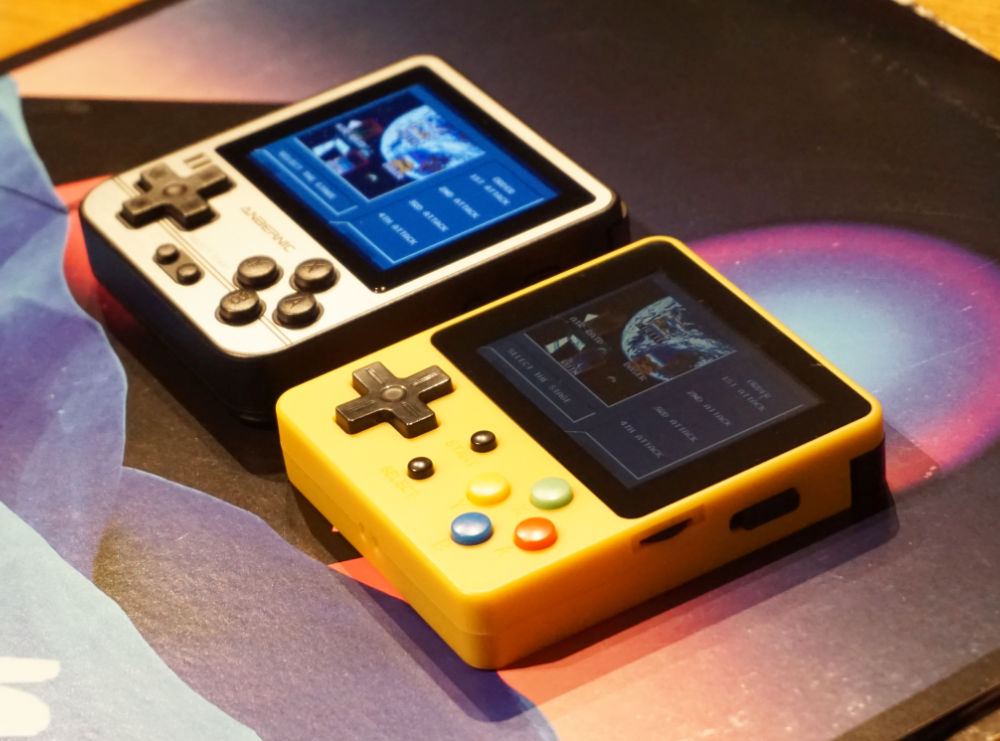
Anbernic have done an amazing job with the design and build quality of the RG280V. Their devices have always felt good, but as their portfolio has grown and they’ve gained more experience they’ve gotten even better. Everything about the Anbernic RG280V feels premium. In fact there is very little to set it apart from a Sony or Nintendo built handheld.
The brushed metal face plate is the perfect trade off between an all plastic device and their more expensive metal models. The slightly raised LCD lens is gently domed at the edges, bringing it neatly and smoothly towards the face of the handheld. The screen is also OCA laminated, meaning there is no air gap between the lens and the LCD itself. This improves clarity and contrast, whilst also eliminating the possibility of any dust getting in there.
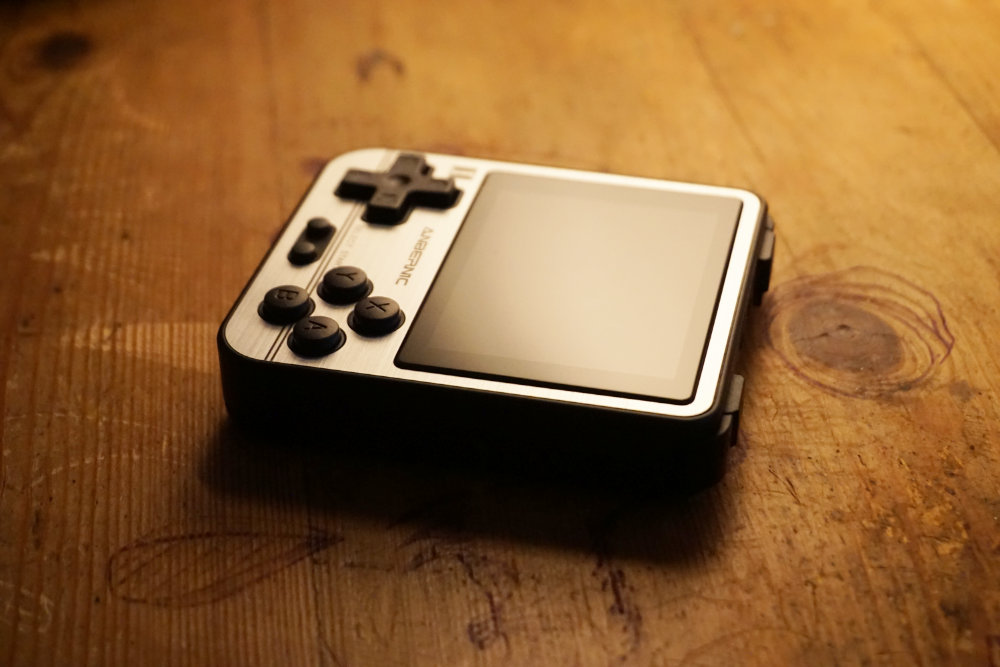
The plastic moulding is exceptionally high quality and has a very fine matte finish to it. There’s very little button rattle, it doesn’t creak or flex and the software is excellent (although that’s thanks to community developers rather than Anbernic).
RG280V CONTROLS
Perhaps the biggest innovation in this model is the layout of the shoulder buttons. The R2/L2 buttons are nestled right in to the R1/L1, and raised a millimetre or two higher up. By resting your index finger on each corner, you can very easily detect and press any of them. They are easily clicked in from almost any angle, and the difference in height leaves you with no doubt of which one you’re hitting. It’s much more comfortable to play than the original LDK, but for larger hands it can become uncomfortable after a while. In between the shoulder buttons sits the USB-C charge port, the 3.5mm headphone jack and a status LED.
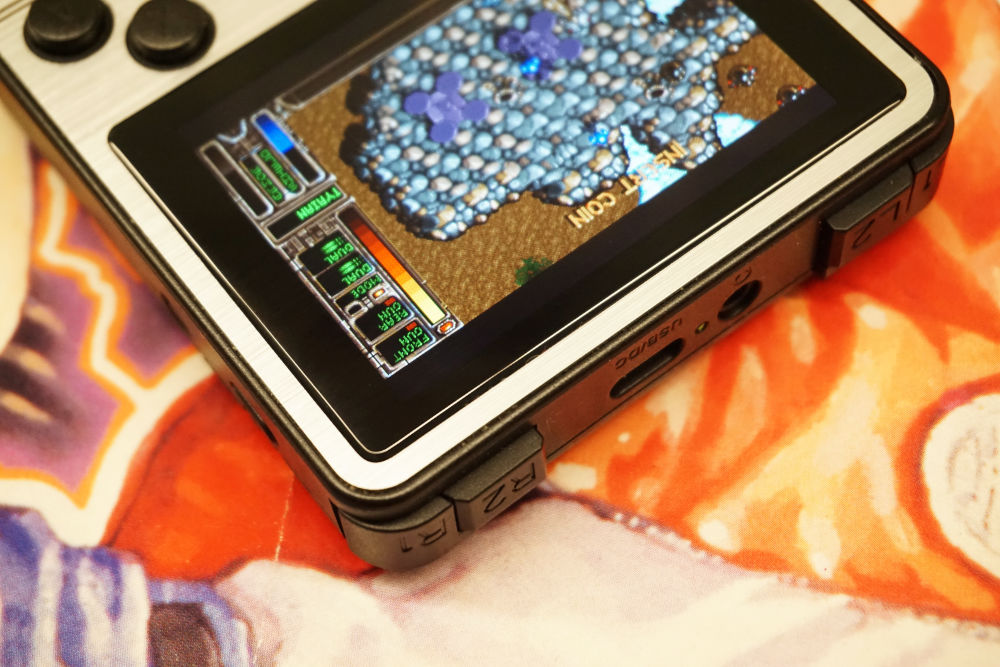
The D-Pad and ABXY buttons are usual Anbernic quality. That is to say there’s no real improvements that could be made. If I was to pick fault I’d say the D-Pad is perhaps a little stiff. I expect it’ll loosen up over time as the membrane softens.
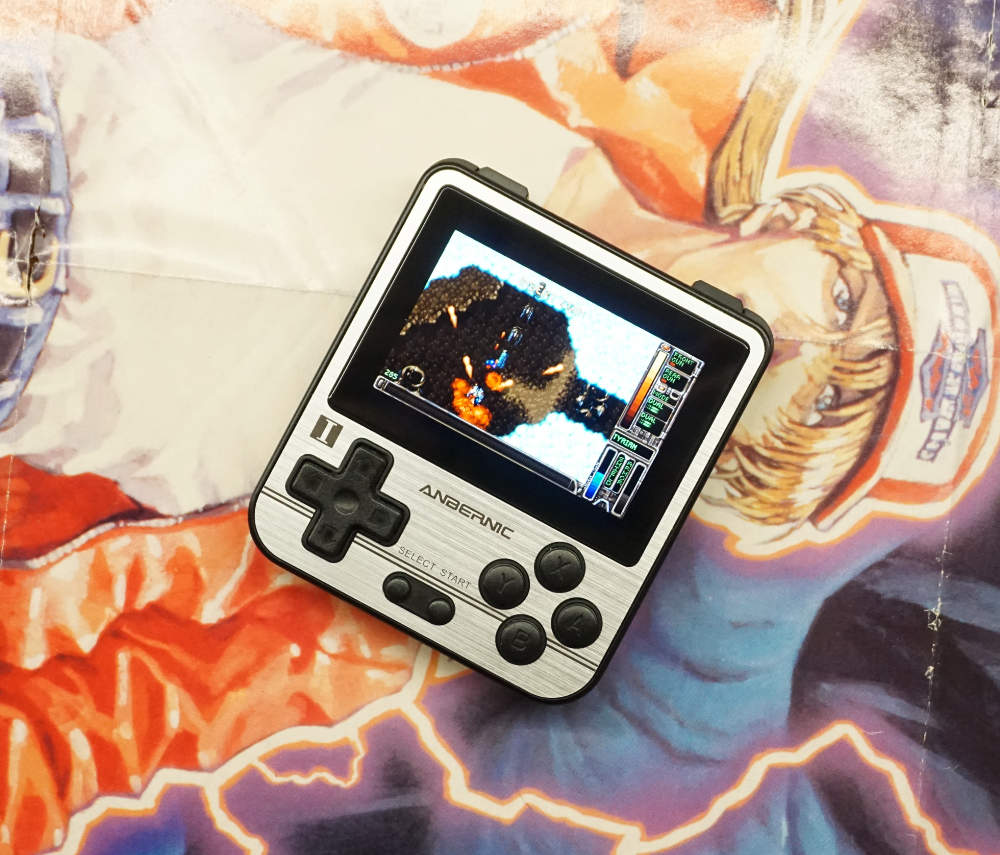
The RG280V has a digital volume rocker that sits flush on the left hand side, and below that you’ll find two microSD card slots. On the right side is a power button and a reset button. The power button sits flush, and the reset button is recessed by about a millimetre.
RG280V LCD SCREEN
As previously mentioned, the LCD is OCA (Optically Clear Adhesive) laminated, which gives excellent clarity. The 2.8″ IPS display itself is bright and colourful, with perfect viewing angles all the way down in every direction.
I should note here that some people have reported the screen lens not being properly adhered to the shell. I’ve seen some pictures of the lens lifting off in the top corner on some devices. I don’t know whether this was a teething problem early on in manufacture or not. For what it’s worth, there is no sign of any peeling on mine and I waited a week or two before ordering.
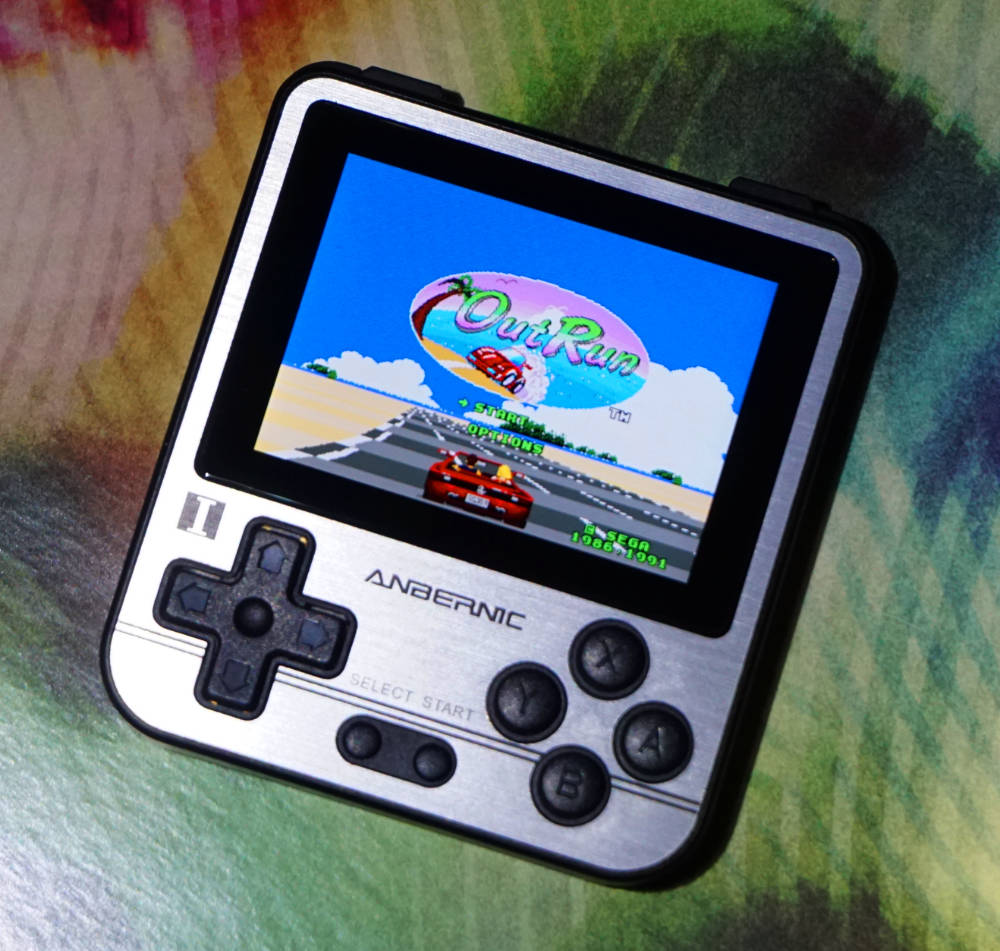
For all intents and purposes the resolution of this screen is 320×240, but you’ll often see it described as 320×480. The LCD has a non-standard pixel structure. What that means for us laymen is that if you really look closely you’ll see that every vertical straight line is slightly jagged, because the pixels aren’t square. On a screen this size it’s hard to make out. Some people argue that it gives a more authentic look, others prefer square pixels. For scaling non-integer resolutions like the GBA’s 240×160, I think it looks better than a standard 320×240 display.
The below image shows the difference in pixel grid between the RG280V and RG350M. It’s most obvious in the text at the top. On a side note, you can also see that the RG280V LCD is a lot colder than the RG350M.
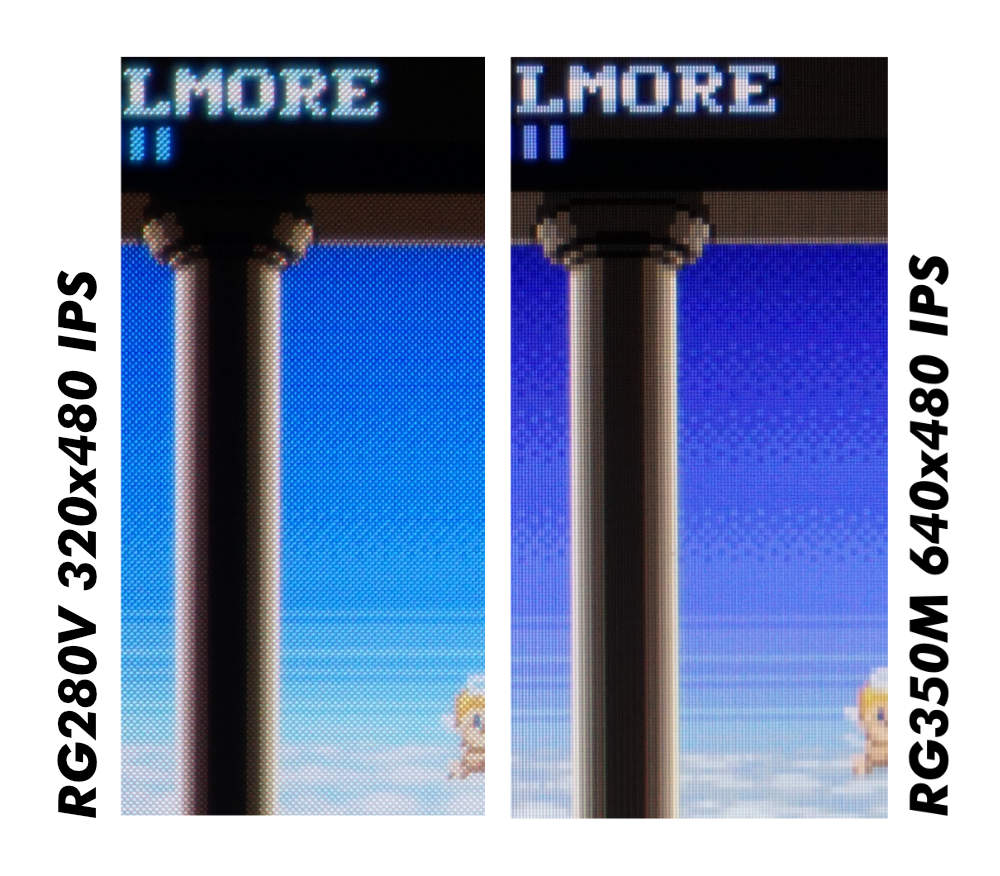
I wish they’d just gone for a 640×480 display like they did for the RG350M, though. That higher resolution in such a small LCD would have looked amazing. It is telling that this is my biggest gripe with the system, and it’s really not that big a deal.
RG280V EMULATORS
Most of you will know the drill by now, this is an Ingenic JZ4770 handheld. It’s a MIPS based CPU from around 2012 which runs at 1Ghz. The stock system includes many emulators that have had many years of optimisation for this CPU. As such, for the consoles it supports you can expect very good performance. There are emulators for the following systems included on the device:
- NES
- SNES
- Mega Drive
- Game Boy / Colour
- Neo Geo Pocket Color
- Wonder Swan
- PS1
- Game Boy Advance
- MAME
- Final Burn Alpha
- DosBox
There are tons more emulators, ports and applications available for OpenDingux. Some of the emulators included in the stock image are a little out of date now, and it can be difficult to find the latest compatible versions. The best place to start if you’re looking for something in particular is probably this repository. There is also a new version of ReGBA that adds a really nice 2x Hardware scaler which is available here. I’ve tested it on the Anbernic RG280V and it works.
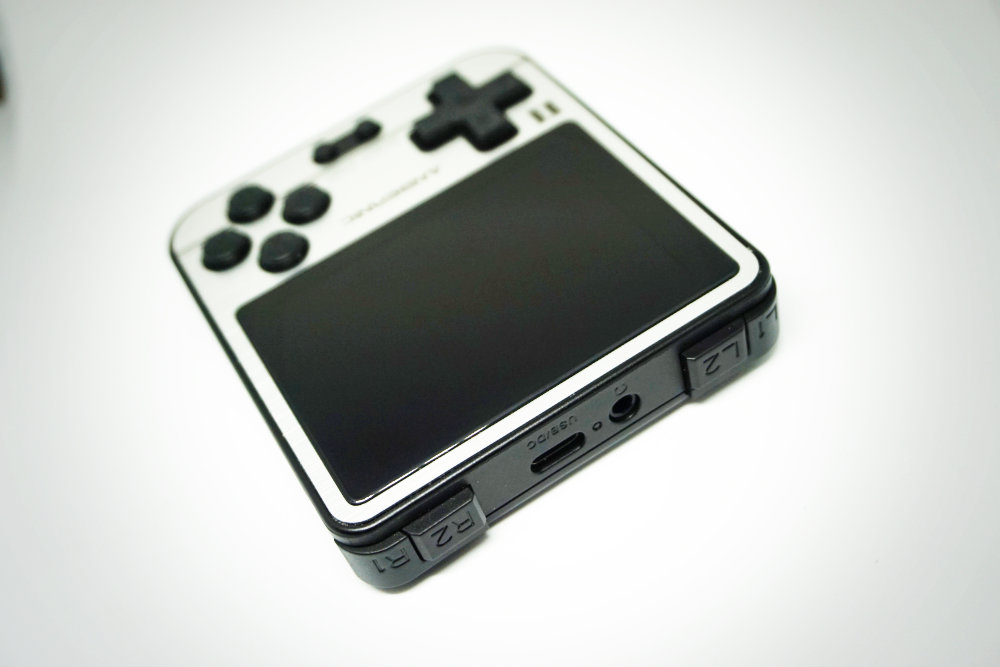
To add them to your handheld, just plug it in to your Windows PC with the supplied USB-C cable and launch the Network application in settings. Select login without password, then open IP address 10.1.1.2 with username “root” in WinSCP or Filezilla. Add the *.opk file you downloaded to the /media/data/apps location, and it’ll show up in the menu automatically.
Alternatively, you can just create a folder calls apps on a secondary SD card, and put your *.opk files there. They’ll show up in the menu automatically too.
RG280V SPEAKER
The speaker on the RG280V is mono which isn’t really surprising on a device this size. It’s not bad, not as good as the RG350M but perfectly passable and quite loud. I do kind of wish that the lowest volume was a little bit lower, but it’s pretty quiet and may be fixed in software at a later date. The speaker is located on the back of the device, and it’s high enough up that you won’t cover it up with your hands whilst playing.
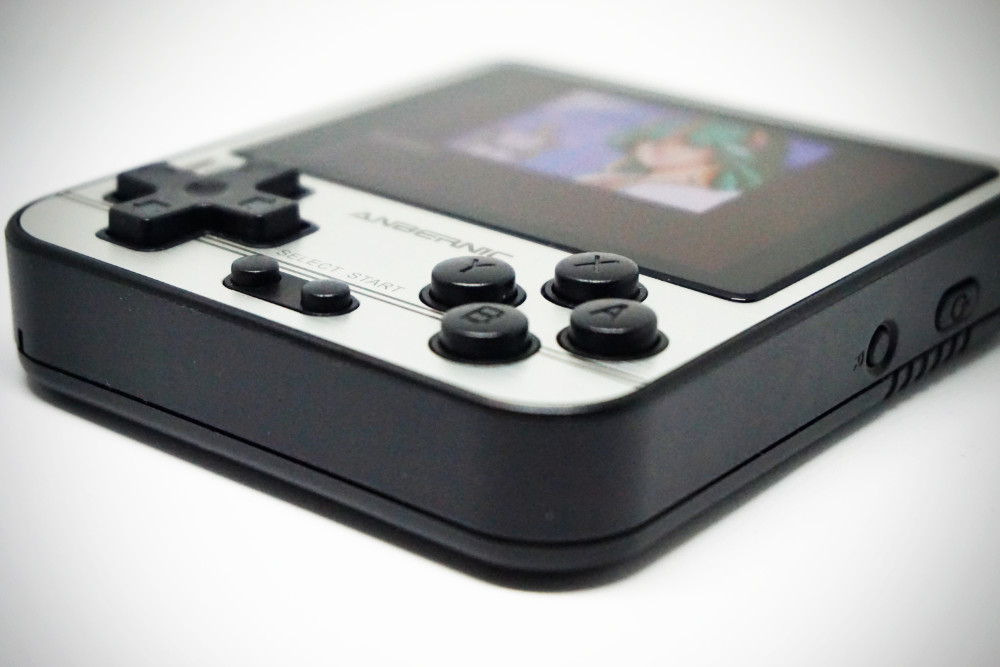
While on the subject of sound quality, you might notice that when you load a game the speaker emits a singular “pop” before the game launches. It doesn’t happen during gameplay, only when a game is first launched. The RG350M and RG280M also have the same bug. It’s mildly irritating at worst.
SHOULD YOU BUY AN RG280V?
Well it depends. If you must have N64, Dreamcast, PSP etc then this class of handheld isn’t for you. Check out the RG351P, or any other of the RK3326 handhelds instead. If you don’t care about size or emulating more recent devices you might be better off with an RG350P, especially if you have larger hands. For those that already own an RG350M, you’ve already got what I reckon is the cream of the crop in this CPU category. If you like the metal shell but the RG350M is too big, check out the RG280M. It’s a bit cheaper than the RG350M too.
If you want an extremely portable handheld and don’t mind the lack of analog input, the RG280V is probably the best in its class. With the aforementioned caveats in mind, the RG280V is an awesome little handheld.
P.S. Apologies for the poor quality photos. I have to rely on natural light to get half decent shots, and here in the UK we’ve had very little of that in the past few days!
P.P.S In the past couple of days Ninoh-Fox has released the Rogue OS for this handheld. You can find the image here. If you’re interested in trying it but are cautious of breaking something, flash it to a spare SD card first. You can always revert if necessary. The Stock OS can also be found here, minus any ROMs.


Which screen is sharper for GBA Games, this one or the one of the 280M?
The screens in the RG280V and RG280M are identical. Same size, same resolution, same non-standard pixel arrangement.
Thank you very much, it’s the Rg280M for chriszmas then (metal casing and lovely pink gradient color).
I appreciate that you brought the pixel grid issue front and clear, BTW I had an RG300 with 2.8″ screen for some weeks and I must admit that, although I thought the matrix issue would be a deal breaker, it actually wasn’t. Sure it blurs things a bit, but you have to have a very good eyesight to notice, at this small screen size. In the end I returned the item not because of that but because it should’ve been a 3″, not 2.8″
I think the earlier RG300 models without an IPS display were 3″, but when they swapped to IPS we lost 0.2″ in size. Don’t quote me but I think that’s what happened.
Very good article, I can subscribe every word. And to answer the question, do we need this? No, I guess we do not, but I am enjoying it a lot.
Thank you mate, and yes I really like the device too. I also hope this is the last of the JZ4770 machines 😀